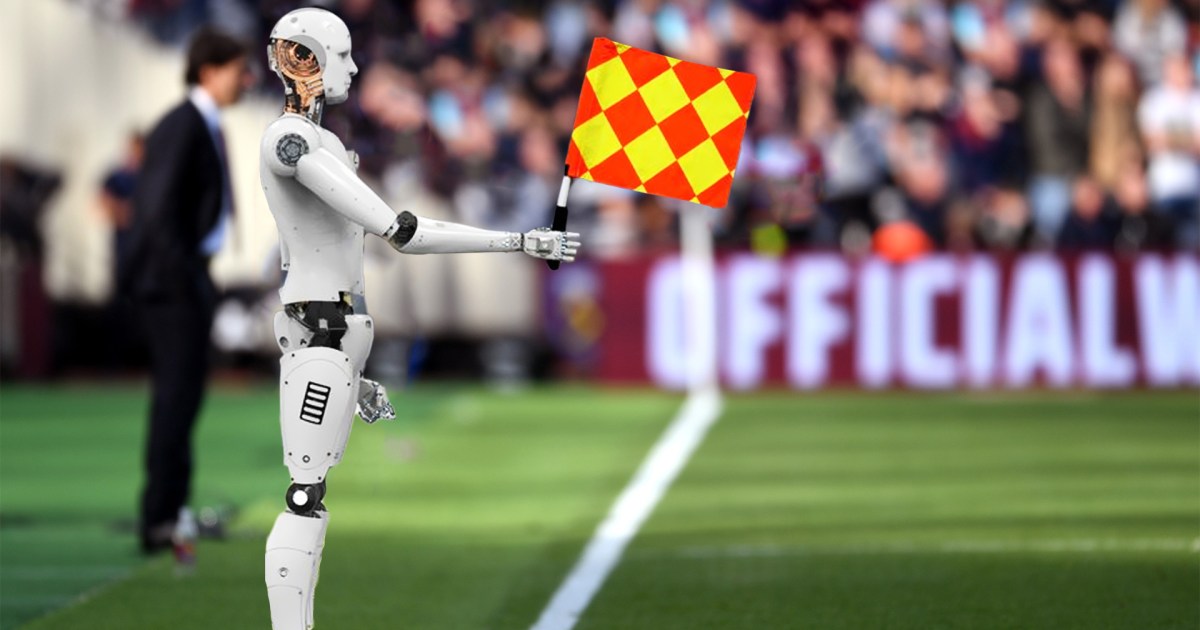Preparations have been completed for the first participation of robots in the refereeing for the 2022 FIFA World Cup in Qatar, for the first time in the history of the largest tournament for the round witch.
And the British newspaper "The Sun" reported that FIFA President Gianni Infantino is keen to introduce the "semi-automated" system through the "line man" robot at the World Cup, whose matches will start next November. After a series of trials in some recent FIFA tournaments.
And the “line man” was the old name of the assistant referee, until the eighties of the last century, when his task was limited to infiltration and the exit of the ball outside the lines, but his tasks expanded since the 1994 World Cup in the United States and his tasks expanded little by little until he reached his effective participation in calculating kicks. The penalty is close to it.
10 cameras
The newspaper said that this “line man” robot uses 10 cameras to track 29 physical points for each player with high accuracy, noting that its use is not a product of the moment, but several experiments were conducted on it, starting in the Club World Cup in 2019 won by Liverpool, and the Arab Cup that was held in 4 of the eight World Cup stadiums in Qatar at the end of last year, and finally the FIFA Club World Cup, which was held this year in the UAE.
The newspaper adds that all evidence confirms that the new technology in offside is much faster than it is under the video assistant referee (VAR) technology, so it is scheduled to be approved for use in the World Cup, during the belated annual general meeting of FIFA on Monday in Qatar, which was postponed from Last March in Zurich as a result of the Russian war on Ukraine.
The “Sun” indicated that the Italian Pierluigi Collina (chairman of the FIFA Referees Committee) criticizes the use of the term “offside robot” and believes that referees and assistants “are still responsible for making decisions on the field of play, and that technology only gives them valuable support to make faster and more accurate decisions, especially When the decision to offside is very difficult."
Automatic infiltration in the Club World Cup
And the automated infiltration technique, using the “line man” was officially used for the first time, in the Club World Cup in the UAE this year, as the speed of its decision-making far exceeds the video assistant referee’s decision, as it informs the mouse of the presence of infiltration within only half a second, through technology Modern relies on tracking the players' parties and the ball, which are the main determinants of offside.
Article 11 of the Football (Offside) Law states that a player is penalized for being in an offside position at the moment the ball is played or touched by one of his teammates if he participates in active active play by interfering with play or with the opponent or obtaining an opportunity and taking advantage of Being in an offside position if the ball rebounds to him, whether from the post, the crossbar or the opponent.
To activate the automated infiltration technology, cameras are installed parallel to the two touch lines around the field to capture the movement of players and the ball, and the technology gives about 29 data points for each player by creating three-dimensional visual representations, to distinguish whether a football player is advanced in any part of his body, as is the case in video games .
A new era in the world of arbitration
Automated infiltration represents a new era in the world of refereeing after the mouse technique, in order to determine whether there is infiltration or not more accurately and quickly than the mouse, to reduce offside errors that may change the results of matches.
"This data source can have a positive impact on the game by improving (offside) decision-making and increasing objectivity," said Johannes Holz Müller, FIFA Director of Football Technology and Innovation.
"FIFA's approach when it comes to tracking the parties involved in this offside technique is the right one," Dr. Patrick Lucy, chief scientist at sports data company Stats Perform told Forbes.
Artificial intelligence
He adds, "Artificial intelligence is used to give accurate measurements and create offside lines that had to be drawn manually in the past, and this eliminates human error, and it does not mean that the human factor is completely absent, as the referee or assistant referee can look at the image created by the artificial intelligence, and know the immediately determines whether a player is offside, but the referee can also use his own judgment to decide whether that player is interfering with play, or if there is any other reason to award the goal.
Dr. Lucy explains that this approach combines "getting humans to do what they do really well, and getting computers to do what they are really good at."
That is why Colina said this is not an "automated infiltration".
The writer points out that although TV broadcasts do not provide the quality of the live tracking technology required for the parties to make accurate arbitration decisions, artificial intelligence will be able to use TV broadcasts to generate real-time statistics including expected goals, the estimated position of players on the field, and are That's using a fingerprint of player tracking data for the past 20 years, along with machine learning algorithms to estimate the whereabouts of players who aren't on screen.
Former international referee

